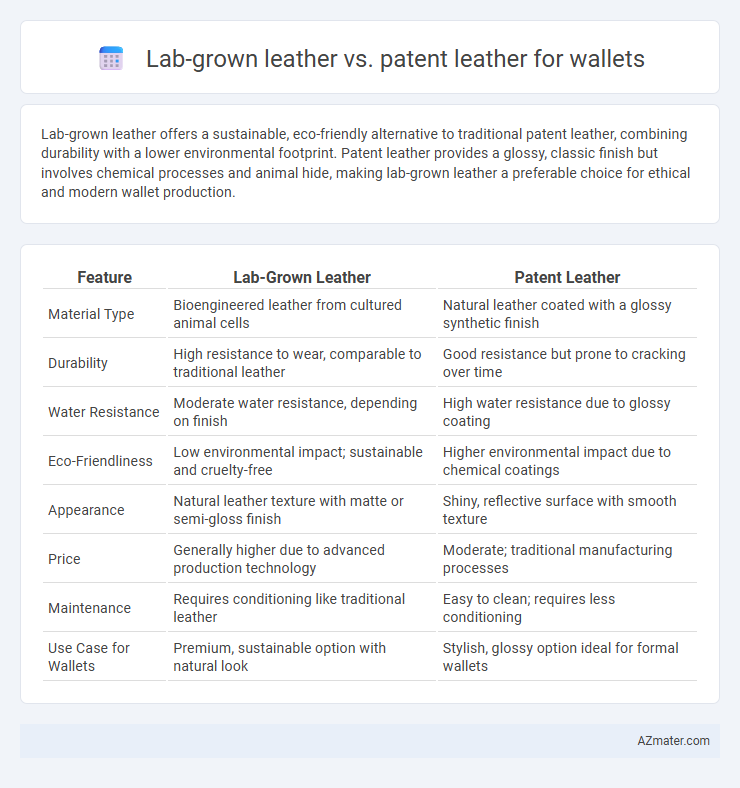Lab-grown leather offers a sustainable, eco-friendly alternative to traditional patent leather, combining durability with a lower environmental footprint. Patent leather provides a glossy, classic finish but involves chemical processes and animal hide, making lab-grown leather a preferable choice for ethical and modern wallet production.
Table of Comparison
| Feature | Lab-Grown Leather | Patent Leather |
|---|---|---|
| Material Type | Bioengineered leather from cultured animal cells | Natural leather coated with a glossy synthetic finish |
| Durability | High resistance to wear, comparable to traditional leather | Good resistance but prone to cracking over time |
| Water Resistance | Moderate water resistance, depending on finish | High water resistance due to glossy coating |
| Eco-Friendliness | Low environmental impact; sustainable and cruelty-free | Higher environmental impact due to chemical coatings |
| Appearance | Natural leather texture with matte or semi-gloss finish | Shiny, reflective surface with smooth texture |
| Price | Generally higher due to advanced production technology | Moderate; traditional manufacturing processes |
| Maintenance | Requires conditioning like traditional leather | Easy to clean; requires less conditioning |
| Use Case for Wallets | Premium, sustainable option with natural look | Stylish, glossy option ideal for formal wallets |
Introduction to Lab-Grown Leather and Patent Leather
Lab-grown leather, created through biofabrication processes using collagen cells, offers a sustainable and eco-friendly alternative to traditional animal hides, minimizing environmental impact and ethical concerns. Patent leather, characterized by its glossy, high-shine finish achieved through a coating of lacquer or synthetic materials, provides durability and a polished look for wallets but relies on conventional leather sources. Comparing these materials highlights lab-grown leather's innovation in sustainability versus patent leather's established reputation for style and resilience.
What is Lab-Grown Leather?
Lab-grown leather, also known as cultured or bio-fabricated leather, is produced by cultivating animal cells in a controlled environment to create a sustainable and ethical alternative to traditional leather. This innovative material offers the same texture and durability as genuine leather while minimizing environmental impact by reducing the need for livestock farming and chemical tanning processes. For wallets, lab-grown leather combines luxury aesthetics with eco-friendly practices, making it a compelling choice compared to patent leather, which is typically made by applying a glossy, plastic coating over natural leather.
What is Patent Leather?
Patent leather is a type of coated leather characterized by its high-gloss, shiny finish achieved through a layer of lacquer or varnish. It is traditionally made from animal hide, treated to create a smooth, reflective surface that is both durable and water-resistant. Lab-grown leather, by contrast, is an innovative, sustainable alternative produced through biofabrication techniques, offering similar durability and aesthetic qualities without the environmental impact of conventional leather production.
Durability Comparison: Lab-Grown vs. Patent Leather
Lab-grown leather offers exceptional durability due to its consistent fiber structure and resistance to cracking and peeling compared to patent leather, which is prone to surface scratches and may develop creases over time. Patent leather's glossy coating can wear off with prolonged use, reducing its longevity, whereas lab-grown leather maintains its texture and strength with minimal maintenance. For wallets, lab-grown leather provides a more resilient and sustainable option that withstands daily wear better than the traditional shiny finish of patent leather.
Environmental Impact: Sustainable Choice for Wallets
Lab-grown leather significantly reduces environmental impact compared to patent leather by minimizing water usage and eliminating harmful chemical treatments. Unlike patent leather, which often relies on toxic solvents for its glossy finish, lab-grown leather production emits fewer greenhouse gases and supports sustainable resource management. Choosing lab-grown leather wallets promotes eco-friendly practices and reduces the carbon footprint associated with traditional leather manufacturing.
Aesthetics and Texture Differences
Lab-grown leather offers a natural, supple texture with visible grain patterns that enhance the wallet's aesthetic appeal through a matte or semi-gloss finish. Patent leather stands out with its high-gloss, reflective surface, providing a sleek, polished look but often feels stiffer and less breathable. The choice between lab-grown and patent leather hinges on whether a wallet's user prioritizes organic texture and subtlety or bold, shiny elegance in design.
Maintenance and Care Requirements
Lab-grown leather wallets require minimal maintenance, needing only occasional wiping with a damp cloth to retain their texture and color, and they resist cracking and peeling better than patent leather. Patent leather wallets demand regular cleaning and polishing to maintain their glossy finish, and are prone to scuff marks and discoloration if exposed to harsh conditions. Both materials benefit from proper storage in a cool, dry place away from direct sunlight to extend wallet longevity.
Price and Accessibility
Lab-grown leather offers a more affordable alternative to patent leather, often priced 20-30% lower due to sustainable production methods reducing material costs. Accessibility for lab-grown leather is expanding rapidly, with increasing availability from eco-conscious brands and online retailers. Patent leather remains widely accessible through traditional fashion outlets but generally carries a higher price point reflecting its established manufacturing processes and glossy finish.
Ethical Considerations: Animal-Free vs. Traditional
Lab-grown leather offers an ethical alternative to traditional patent leather by eliminating the need for animal hides, reducing animal cruelty and the environmental impact linked to livestock farming. Patent leather, derived from animal skins, raises concerns about animal welfare and contributes to deforestation and greenhouse gas emissions. Choosing lab-grown leather wallets supports sustainable fashion through animal-free production methods while maintaining durability and aesthetic appeal.
Which is Better for Wallets? Final Verdict
Lab-grown leather offers superior sustainability and natural texture, making it an eco-friendly choice for wallet durability and comfort, while patent leather provides a glossy, polished finish that resists water and stains but may crack over time. Lab-grown leather's breathability and flexibility make wallets more comfortable for daily use, whereas patent leather wallets excel in aesthetic appeal and easy maintenance. For long-term wallet performance and environmental impact, lab-grown leather is the better choice, while patent leather suits those prioritizing sleek style and easy cleaning.

Infographic: Lab-grown leather vs Patent leather for Wallet
 azmater.com
azmater.com